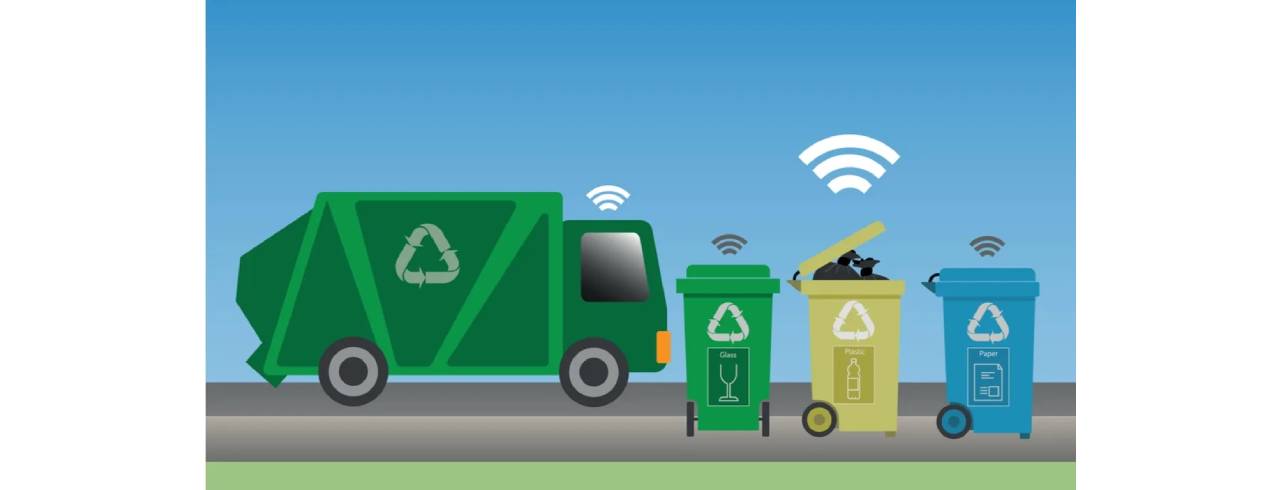The IoT in waste management is an essential component in the development of intelligent buildings, particularly in real-time system management & monitoring. But with projections showing that approximately two-thirds of the worldwide people will be residing in urban places by the year 2030, one of the most significant difficulties that cities will face is how to properly dispose of their garbage.
With the Internet of Things (IoT) - enabled systems using Arduino, cities can utilize trash pickup, decrease the number of uncollected rubbish, and better manage resources.
Innovative IoT-based smart waste management becomes an essential ecosystem component that supports smart cities.
The utilization of waste management using IoT can cut down on pointless expenditures, which are the consequence of operational problems in the procedures involved in trash collection.

Mobile networks, which will account for approximately three-quarters of linked smart waste management systems using IoT locations in 2020, are the primary support system for intelligent garbage cans. Wireless sensor nodes are progressively being well before into waste bins. Although it is possible to retrofit existing units, this is becoming less common.
Because of their low cost, high power efficiency, ability to leverage existing services, and high level of built-in security, these technologies are ideally suited for use in applications related to smart cities.
There are three crucial areas in which the Internet of Things supports procedures for IoT based waste management systems:
· Route optimization
Historically, waste management processes have scheduled garbage pickup and recycling point receptacle discharging according to a predefined route based on historical patterns. This was done regardless of whether or not the receptacles were full.
This model is turned on its head by waste management IoT, which uses smart trash cans to detect destination, temp, & fill levels in real-time. This data can then be used to arrange optimal transportation, which results in a pickup process that is efficient & saves fuel and also manpower.
In addition, data helps with lengthy planning, like determining where additional bins are required and where the number of bins may be reduced.
The information obtained from smart bins makes it possible to cut down on the number of missed pickups and the instances in which garbage cans become overloaded.
If a sensor determines that a container has reached capacity, an alert will be automatically transmitted to waste management, who will then be able to arrange for an additional collection.
· Recycling with intelligence -
Every year, around Fifty million tons of electronic trash, are produced, as stated in a report by the United Nations. E-waste has been singled out as an essential component of solid waste management because the number of tech devices that find their way into landfills is constantly growing.
Electronic waste typically includes potentially hazardous compounds, such as lithium from a cellphone battery that can seep into the groundwater supply if it is not correctly disposed of. Simultaneously, such devices offer a method that is both effective and efficient for recovering precious & base metals, examples of which include gold and copper.
· Data analysis -
Connected sensors track the rate during which bins are filled, and so is the frequency with which they are emptied and the contents of the bins themselves. The Internet of Things management solutions is where everything comes together again and shines the brightest.
The availability of data enables an infinite number of possibilities, including the improvement of bin distribution planning, the elimination of improper disposal methods, and even the reduction of the quantity of the trash disposed of in landfills.
The use of data analytics to analyze patterns enables better planning of waste management procedures, resulting in more efficient use of resources and a more contented population.
A municipality app could also give the public the capacity to input on-the-ground data that can be used, including real-time, when someone reports a smashed bin or something comparable, and add that data to data gathered from various sources, which can further optimize processes. And speaking of a happier populace, an intelligent urban app can give the public the ability to insert on-the-ground information.
An MS50SFB2 device by BLE module is a complete, compact and lightweight, extremely configurable, ultra-low power connectivity BLE 5.0/5.1 Device based on Multi Nordic nRF52 prequel SoCs with optimization and complete broadcast design of 3 types of antenna obtainable: PCB/Ceramic transmitter or u.FL(IPEX) plug for the omnidirectional antenna. It is based on the Bluetooth Low Energy (BLE) 5.0/5.1 specification. Because it possesses complete regulatory certifications, it enables a quicker time to market & reduces the risk associated with creating your Bluetooth design.
How does technology utilized in the process of waste management?
These types of technology increase recycling by easing the use of recyclable materials by producers, empowering consumers to make more informed decisions regarding purchase and sorting, including expanding the range of waste sourcing alternatives available to recyclers. The application of advanced digitalization in waste care and management is primarily in the technology phase.
How can technology be utilized in the process of waste management?
These types of technology increase recycling by easing manufacturers' use of recyclable materials, empowering consumers to make more informed decisions regarding purchase and sorting, and expanding the range of waste sourcing alternatives available to recyclers. The application of advanced digitalization in waste care and management is primarily in the technology phase.
How well does smart trash management operate?
Using mobile apps, sensors, & intelligent monitoring systems, smart waste management using IoT focuses on finding solutions to the challenges that have been previously outlined in relation to solid trash management. Sensors are the initial component of a smart trash management system that will make collecting waste more productive.